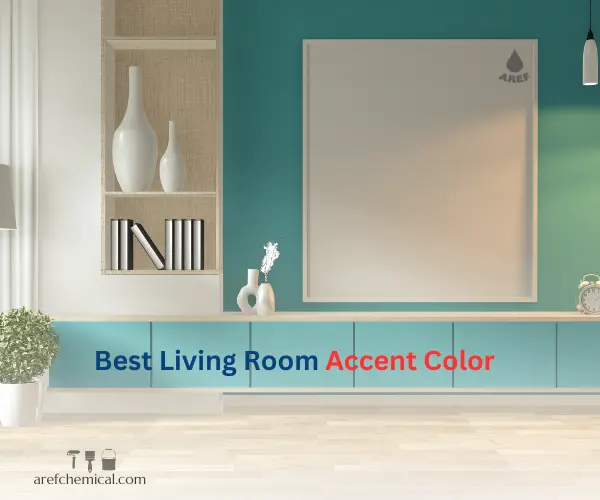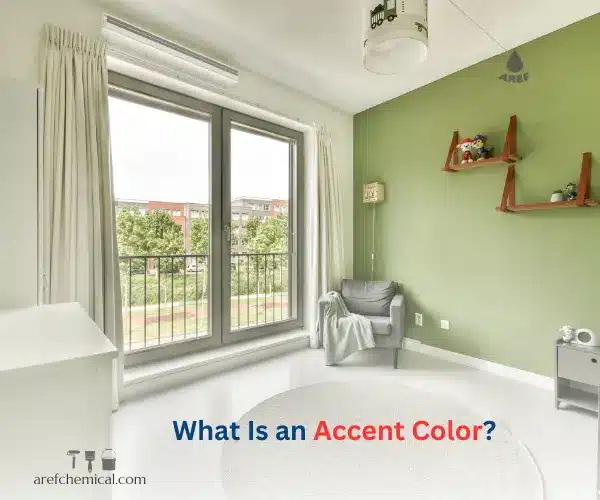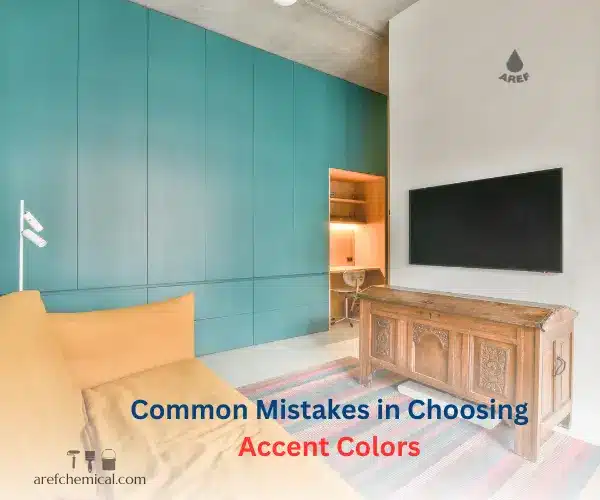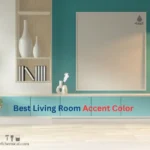The living room serves as the central hub of the home — a place to unwind, connect with others, and host visitors. Choosing the right color for this area is more important than for any other room. Among all color decisions, one choice can transform your living space from ordinary to striking: selecting the right living room accent color. In this article, you’ll learn what an accent color is, how to choose the best living room accent color, practical tips for implementation, and examples of effective color combinations. We’ll also provide recommendations for purchasing and using high-quality paints.
What Is an Accent Color?
An accent color adds contrast and highlights specific elements in interior design, making the space more dynamic and engaging. Unlike main wall or floor colors, which are often neutral and calming, accent colors are vibrant, bold, or eye-catching, drawing attention to a particular spot in the room. In other words, an accent color is used to emphasize a specific part of a design, space, or visual content. The goal is to attract the people’s eye rapidly to that area, making it brilliant. Accent colors are usually vivid and dynamic, such as red, yellow, or orange — often paired with more muted tones to create dramatic contrast.
Common Uses of Living Room Accent Colors:
- Painting one wall a different color (e.g., the wall behind the TV)
- Using bright-colored cushions, curtains, or rugs
- Adding colorful picture frames, vases, or a single bold piece of furniture
Why Use an Accent Color in the Living Room?
- Enhances visual appeal
- Defines a focal point
- Adds warmth or energy to the space
- Breaks monotony and adds variety
- Offers personalization and reflects your lifestyle
Mastering Color Contrast: How to Choose an Accent Hue for Your Living Room
Selecting the best living room accent color requires attention to several important principles to ensure your space is not only aesthetically pleasing but also conveys the right mood and atmosphere. Here are the essential guidelines:
1. Consider the Main Colors of the Room
If your living room is dominated by light or neutral tones (such as white, beige, or gray), you can introduce dark or richly saturated accent colors like navy blue, emerald green, or burgundy to add depth and character.
- Coordination with Lighting
In spaces with abundant natural light, you can use darker and deeper colors. However, if the room is dimly lit, it’s better to choose a bright, vibrant, and warm accent color.
3. Choosing Based on Interior Design Style
- Minimalist: Black, dark gray, olive green
- Modern: Slate blue, mustard, burnt orange
- Classic: Burgundy, gold, chocolate cream
- Boho or Traditional: Turquoise, mint green, brick red
4. The Psychological Impact of Colors
- Blue: Calming, suitable for a peaceful environment
- Green: Balance and freshness
- Red: Excitement and energy
- Yellow: Joy and liveliness
- Purple: Luxurious and unique
Most Popular Accent Colors for Living Rooms
The most popular accent colors for living rooms are often determined based on design trends, color psychology, general preferences, and the specific characteristics of each color. Below are the main methods and influential factors in determining these colors:
-
Design Trends and Fashion
Interior designers, decoration magazines, and specialized interior design websites often publish lists of popular and trendy colors based on yearly trends, favored spaces, and modern design principles. Colors such as:
- Silvery blue or slate blue
- Ramador green or olive green
- Earthy tones and natural dark shades
-
Color Psychology and the Emotions They EvokePopular colors are often those that convey positive and calming emotions or enhance the ambiance of a space, such as:
- Blue: A sense of calm, trust, and peace
- Green: A feeling of freshness, health, and serenity
- Earthy tones and yellow/brown notes: A sense of naturalness, warmth, and intimacy
3. Public Taste and Cultural Preferences
In different cultures, certain colors are more popular. For example, earthy and natural tones are more favored in cultures that emphasize nature. Additionally, colors that align with regional cultural norms are more likely to be embraced.
4. Compatibility with Other Colors and Décor
Popular colors are typically those that harmonize well with other hues and interior design styles, allowing for easy and versatile combinations. Colors that gain popularity in media, fashion, and social design trends often quickly find their way into homes and public spaces. For example, pastel shades or trendy dark colors.
The most popular accent colors for living rooms are generally calming colors (such as blue, green, and earthy tones), natural and nature-inspired shades, and colors that evoke feelings of peace, trust, and warmth. These colors currently top the popularity charts based on design trends, psychological effects, and cultural preferences. Lets look at some of the most loved ones:
- Emerald Green
A royal, modern, and calming color. It looks beautiful when combined with gray or beige. - Petrol Blue
Stylish, luxurious, and great for homes with minimalist design. - Mustard Yellow
Perfect for adding warmth and energy to bright spaces. - Brick Red
A traditional color that conveys liveliness and intimacy. - Burnt Orange
Creative and eye-catching, especially in modern homes.
Where and How to Use Accent Colors
Smart use of accent colors in interior spaces, especially the living room, plays an important role in creating balance, attraction, and focal points. Below are some practical tips and key points for using accent colors effectively:
- Accent Wall
Paint a specific wall in a different color. The wall behind the TV or sofa is usually the best choice. - Decorative Accessories
Cushions, frames, vases, or artwork in accent colors can add a special touch to the room. - Curtains and Rugs
Curtains in an accent color can transform the whole space—especially if the walls are light. - Furniture
Using a single armchair in a bold color is a modern and highly effective technique.
Common Mistakes in Choosing Accent Colors
- Overusing accent colors
- Opting for a color that fails to blend with the existing interior design
- Ignoring the psychology of color
- Selecting a color without testing it under real lighting
- Not considering the season or climate (e.g., cool colors in a cold space may feel gloomy)
How to Test the Right Accent Color
Use a color sample. Check the color in both daylight and nighttime lighting. Instead of paper, use the paint on the intended wall to evaluate the final look. Compare it with other elements in the space, such as curtains and furniture.
Suggested Color Combinations
| Main Color | Suggested Accent Color |
| White | Emerald Green / Petrol Blue |
| Gray | Mustard Yellow / Brick Red |
| Beige | Burnt Orange / Olive Green |
| Cream | Lavender Purple / Turquoise Blue |
Choosing the Right Adhesive for Accent Wall Applications
If you plan to use colored wallpaper, wall decals, or color panels, the type of adhesive matters:
- Non-toxic wall adhesive: Suitable for indoor spaces
- Strong adhesive for painted surfaces: Ensures high durability
- Removable adhesive: Ideal for renters or seasonal changes
Accent Colors and the Seasons
- Spring: Mint Green, Light Blue
- Summer: Lemon Yellow, Ocean Blue
- Autumn: Burnt Orange, Brick Red
- Winter: Navy Blue, Burgundy, Dark Gray
Conclusion
Using Living room accent color is one of the simplest and most effective ways to transform your décor. Such colors bring character to the room, evoke feelings, and break the visual monotony. The key to choosing the right accent color is to consider color harmony, décor style, lighting, and your personal taste. With the right choice, you can create a warm, inviting, and memorable room.
📌 Our suggestion: To purchase high-quality accent colors in a variety of shades that are eco-friendly, visit Arefchemical Online Store today or contact us—our experts are ready to help!







15 Responses
Choosing the right accent colors is a crucial part of any design, whether for interior decorating, graphic design, or branding. However, there are several common mistakes that people often make when selecting accent colors.
Choosing an accent color that clashes with or doesn’t harmonize with the main palette can create visual discord. Always ensure your accent colors complement the primary colors.
Overloading your design with multiple accent colors can lead to confusion and a lack of focus. Stick to one or two accent colors to create a cohesive look.
An accent color that blends too closely with the background or primary colors loses its impact. Aim for high contrast so that the accent stands out effectively.
Trendy colors can quickly become outdated. Select accent colors that resonate with your brand or aesthetic and will remain appealing over time.
Choosing the best accent color for your living room involves understanding how to select, combine, and effectively use colors to enhance the space’s aesthetic and ambiance
Start with the primary wall colors and furniture tones. Neutral bases like beige, gray, or white provide a versatile canvas, allowing accent colors to truly stand out.
Pick a color that resonates with your personality and mood you want to create—calming blues for relaxation, vibrant reds or oranges for energy and warmth, or earthy tones for a cozy feel.
Complementary colors (opposite on the wheel), analogous colors (next to each other), or triadic schemes (three colors evenly spaced) can guide you in selecting harmonious accents.
https://arefchemical.ir/%d8%b1%d9%86%da%af-%d8%a7%d8%aa%d8%a7%d9%82-%d8%ae%d9%88%d8%a7%d8%a8/
Bright, warm colors can energize a space, while cooler tones promote calm. Also, consider natural light—what looks good in daylight may change under artificial lighting.
thank you
Emerald Green and Petrol Blue together are great
Check the color in both daylight and night.
wow accent color
chose a color with testing it under sun lighting